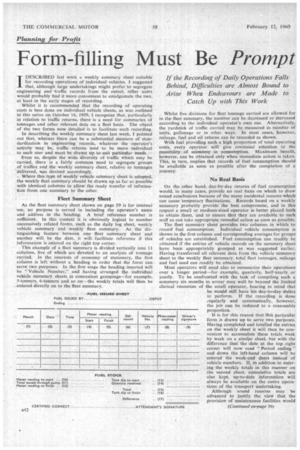Form-filling Must Be Prompt I DESCRIBED last week a weekly summary
Page 76

If you've noticed an error in this article please click here to report it so we can fix it.
sheet suitable for recording operations of individual vehicles. I suggested that, although large undertakings might prefer to segregate engineering and 'traffic records from the outset, other users would probably find it More convenient to amalgamate the two, at least in the early stages of recording.
Whilst it is recommended that the recording of operating costs is best done on individual vehicle sheets, as was outlined in this series On October 16, 1959, I recognize that, particularly in relation to traffic returns, there is a need for summaries of tonnages and other relevant data on a fleet basis. The object of the two forms now detailed is to facilitate such recording.
In describing the weekly summary sheet last week, I pointed out that, whereas there can be a substantial measure of standardization in engineering records, whatever the operator's activity may be, traffic returns tend to be more individual to each user and must be drawn up to suit particular needs.
Even so, despite the wide diversity of traffic which may be Carried, there is a fairly common need to segregate groups of traffics and the weekly summary sheet', relative to tonnages delivered, Was devised accordingly.
, Where this type of weekly vehicle stimmary sheet is adopted, the weekly fleet summary should be drawn up as far as possible with identical columns to allow the ready transfer of information from one summary to the other.
Fleet Summary Sheet As the fleet summary sheet shown on page 59 is for internal use, no purpose is served in including the operator's name and address in the heading. A brief reference number is sufficient. In this context it is obviously logical to number successively related forms, such as the daily log sheet, weekly vehicle summary and weekly • fleet summary.As the distinguishing feature between one fleet •summary sheet and another will be the date, it will facilitate reference if this information is entered on the right top corner.
This example of a fleet summary is divided vertically into 11 columns, five. of which are devoted to an analysis of tonnage carried. In the interests of economy of stationery, the first column is left without a heading in order that the form can serve two purposes. In the first stage the heading inserted will be "Vehicle Number," and having arranged the individual vehicle summary sheets in convenient groupings—for example, 5-tanners, 6-tonners and so on—the weekly totals will then be entered directly on to the fleet summary.
Whilst five divisions for fleet tonnage carried are allowed for in the fleet summary, the number can be decreased or increased according to the individual operator's own use. Alternatively, the yardstick of traffic carried may be measured in number of units, gallonage or in other ways. In most cases, however, mileage, fuel and oil returns can be recorded as shown.
With fuel pioviding such a high proportion of total operating costs, every operator will give continual attention to the possibility of edonomy in consumption. Maximum benefit, however, can be obtained only when immediate action is taken. This, in turn, implies that records of fuel consumption should be available 'as soon as possible after the completion of a .journey.
No Real Basis
On the other hand, day-by-day returns of fuel consumption would, in many cases, provide no real basis on which to draw sound conclusions because of the many incidental reasons which can cause temporary fluctuations. Records based on a weekly summary probably provide the best compromise, and in this respect a small or medium-sized operator is better placed both to obtain them, and to ensure that they are available to such staff as can take appropriate remedial action as soon as possible.
The fleet summary sheet provides two columns in which to record fuel consumption. Individual vehicle consumption is shown in the first column and corresponding averages for groups of vehicles are established. Fuel consumption can readily be obtained if the entries of vehicle records on the summary sheet have been appropriately grouped as was suggested -earlier. Having transferred all relevant data from the vehicle summary sheet to the Weekly fleet summary, total fleet tonnages, mileage and fuel used can readily be obtained.
Most operators will need also to summarize their operations over a longer period—for example, quarterly, half-yearly or yearly. To be confronted with the task of compiling such a summary six months in arrear may well be beyond the limited clerical resources of the small operator, bearing in mind that he would still have his day-to-day duties to perform. If the recording is done zegularly and systematically, however, the job can be reduced to a reasonable
proportion.
It is for this reason that this particular form is drawn up to serve two purposes. Having completed and totalled the entries on the weekly sheet it will then be convenient to accumulate these totals week by week on a similar sheet, but with the difference that the date at the top .right corner will now read "Period ending" and down the left-hand column will be entered the week-end dates instead of vehicle numbers. If, in addition to entering the weekly totals in this manner on the second sheet, cumulative totals are also kept, up-to-date information will




















































































































